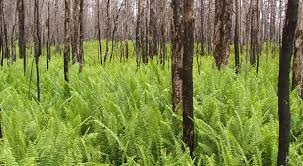Rising levels of atmospheric nitrogen pollution threaten plant diversity at nearly one-quarter of sites across a widespread portion., according a new study.
The findings, are the first to examine ecosystem-specific vulnerabilities to atmospheric nitrogen pollution on a continental scale.
Nitrogen plays an important role in biological processes and makes up a key element of fertilizer, but previous research has shown that it is possible for plants to get too much of a good thing. Global emissions of nitrogen to the atmosphere have tripled in the last century due to agriculture and industry, and elevated levels of nitrogen have been shown to cause environmental damage, including decreased plant species richness in experimental plots.
The study examined more than 15,000 forest, woodland, measuring the threshold at which nitrogen inputs become harmful to plants while also taking other environmental factors such as climate and soil conditions into account.
In all, 24% of the sites surveyed were at or above levels that result in plant species losses, with grassland regions (especially those with acidic soil) being most vulnerable. Groundcover plant species in forested regions with neutral pH soil were found to be the least vulnerable.
The findings may have wide-ranging implications for future air quality standards and biodiversity conservation efforts. Air pollution, along with habitat loss, is a major factor implicated in the loss of diversity.
“Plant species diversity acts as an ecological buffer against events such as drought,” said William Bowman, a professor in the Department of Ecology and Evolutionary Biology and a co-author of the study. “If we see a reduction in plant species in some ecosystems as a result of atmospheric nitrogen, that might lead to unintended consequences and affect communities adversely.”
Source: Science daily
N.H.Kh

